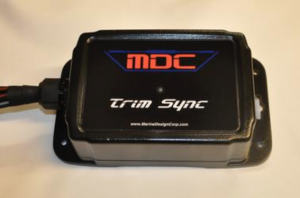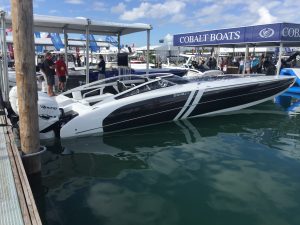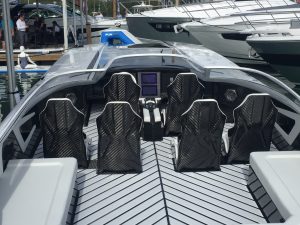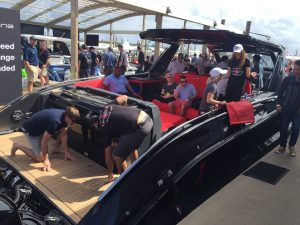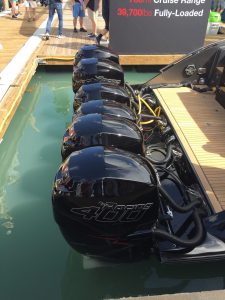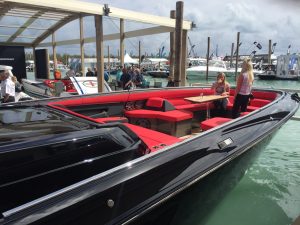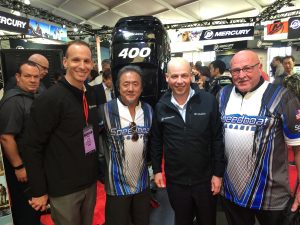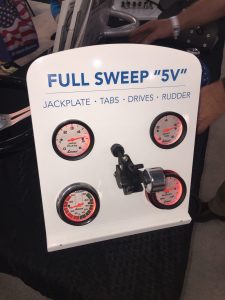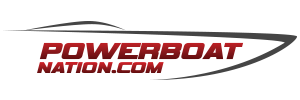Recently, DCB Performance Boats of El Cajon, CA, announced its plans to create a center console boat to compete against East Coast offerings from Mystic, MTI, Nor-Tech, Fountain and other builders that have enjoyed considerable success with their own high-performance models in this configuration. To help bring DCB’s vision to life, company President Jeff Johnston reached out to Franco Gianni, the mastermind behind SFG Yacht Design, based in Miami and Dubai. It was an inspired choice: Gianni brings more than 15 years of experience in the marine industry, as both a captain and designer in luxury yachts. Well known for his intricate handiwork and sleek creations, he’s the driving force behind boats like the 53 CCV, 60 CCV and G2 60 models, all exquisitely crafted, top-of-the-line luxury center consoles.
SFG will help DCB create the first high-performance center console offered by a West Coast muscleboat builder. The collaboration will result in a 42-foot center console being readied for spring of 2020.
Powerboat Nation caught up with Gianni at the recent Miami Boat Show to ask him about his design and working with DCB on the new model.
PBN: You’ve been very successful creating very fine, high-end pleasure craft, often as a designer-for-hire.
FG: That’s what we do. We help companies come out with a killer product that’s different from what everybody else does and has its own personal touch to it. We’re happy to see everybody’s brands grow.
PBN: How did SFG become involved in your latest project?
FG: Jeff at DCB gave us a call and asked if we could help him develop the 42CC center console for them. They provided a great set of notes and really knew what they wanted.
PBN: What stage are you at in the boat’s development at present?
FG: We met with Jeff here at the Miami show and discussed the project a little bit further in detail. The boat’s being engineered as we speak, and then we’ll start building it. I believe the launch is scheduled for spring of 2020. We’re really looking forward to its development and its launch next year.
PBN: Which specific East Coast models will DCB’s 42CC directly compete with?
FG: I think this boat will be targeted at the 42′ Mystic and the 42’ MTI. It’s in that luxury adult center console—an elegant, a refined design of everything else that’s out there, but with their own twist and with the detail that DCB goes into, with their upholstery, their dashes, things like that. This boat is really designed to be set apart. We’ve given a DCB a cool, easy platform to work with, and I have no doubt that this boat is going to be a gem once it’s done.
PBN: It’s actually remarkable how none of the West Coast builders have tried to capitalize on the popularity of the center console market.
FG: Nobody on the West Coast has done a center console like this before, and I think it really gives DCB the upper hand and an upper edge. And I think the 42CC is really going to have a huge appeal across the country. On the East Coast, the Florida and Caribbean boating scenes, people have been waiting for cooler products in that same sector. People are used to seeing them in those areas. But people aren’t really accustomed to seeing a West Coast company build a product like what’s about to come from DCB. It’s going to really appeal to the guys who have owned DCBs before. They are already familiar with the high quality of their boats, and they’re going to be excited about what’s coming out and maybe even get their hands on one.
PBN: For 16 years, you were a captain of superyachts of all different shapes, colors, sizes, all around the world. How did that prepare you for what you’re doing now?
FG: All of that was to better our experience and education with yacht design, and perfecting the craft. About five years ago, we opened up the studio full time and developed the first 60-foot center console. We designed, manufactured and delivered to its owner in Dubai. That was a pretty big step into the small boat world; prior to that, we’d always been in the large superyacht sector, designing bigger boats, refits and new builds.
PBN: Who is the ideal customer for this new DCB center console?
FG: This is for the guys who are moving up from the high-performance catamarans and are looking for something that’s top-notch quality and just as much fun to play with, but they can take along the family, friends, the wife, the kids. This is the boat for them. It’s going to put DCB on the map in a whole different way very quickly. And I think it’s going to do wonders for the industry.
UPDATE: As work on the 42CC continues, Powerboat Nation checked in with DCB to let Jeff Johnston weigh in.
“We’re excited—it’s the first endeavor with a vee-bottom center console,” Johnston says, adding that “SFG’s previous work speaks for itself. I admire all their creations, their creativity, attention to detail and the professionalism they brought to all of their larger boat builds.”
Asked if good progress was being made on the boat, Johnston says, “Yes, quite a bit. We’re almost done with the entire deck design, the top deck, the center console, the stringer system, and now we’re working on finalizing the bottom hull design.”
After finishing the bottom, DCB will focus on the boat’s running surface and step placement. Afterwards, the full design of the boat will be sent to DCB’s vendor in Florida as a CAD file to CNC machine a full-scale foam plug that measures 42 feet by 11.5 feet. The DCB crew will be making trips back East to monitor progress on the boat “to make sure that we’re headed in the right direction before everything’s finished,” Johnston says.
He adds that DCB has already taken two deposits from customers who want the first hulls, and that as many as 10 additional customers have expressed serious interest in purchasing the 42CC as well.
The boat will be equipped with three, four or five Mercury Racing 400R outboards.





